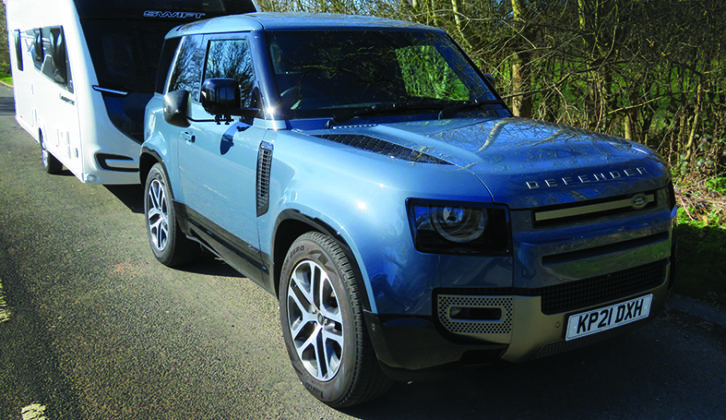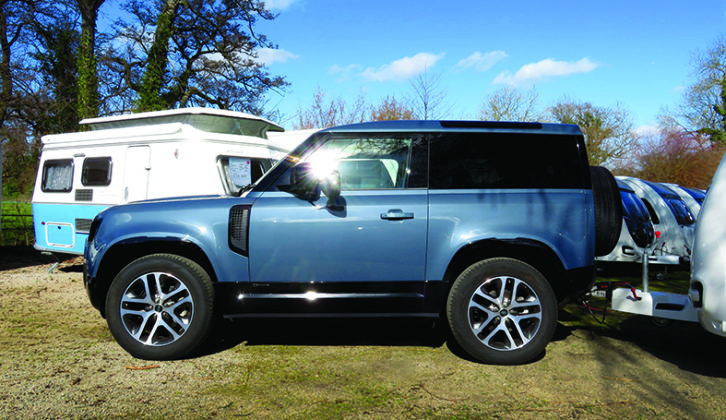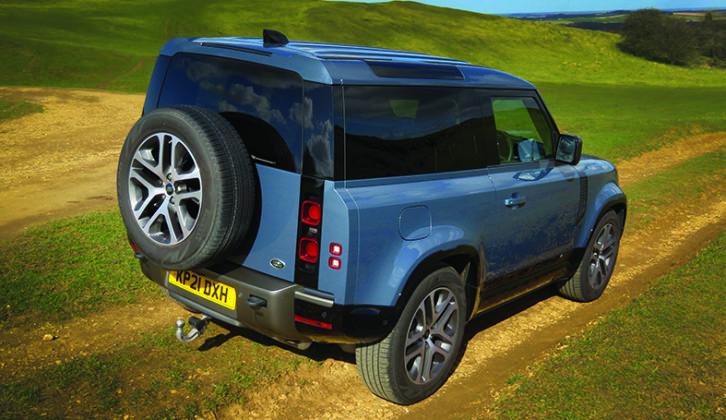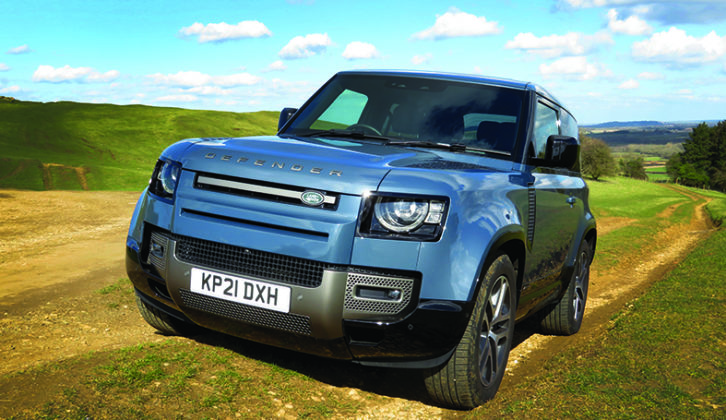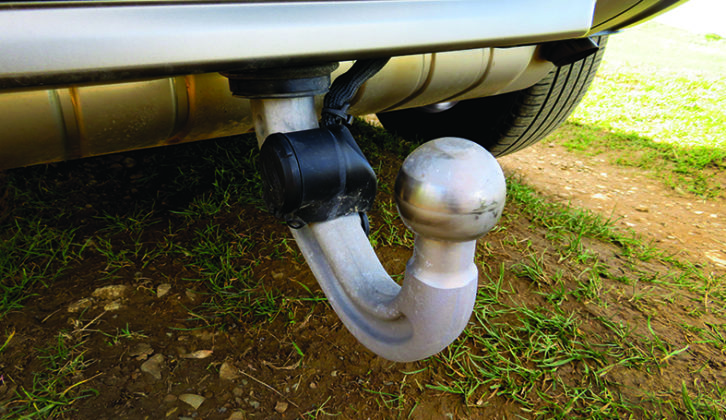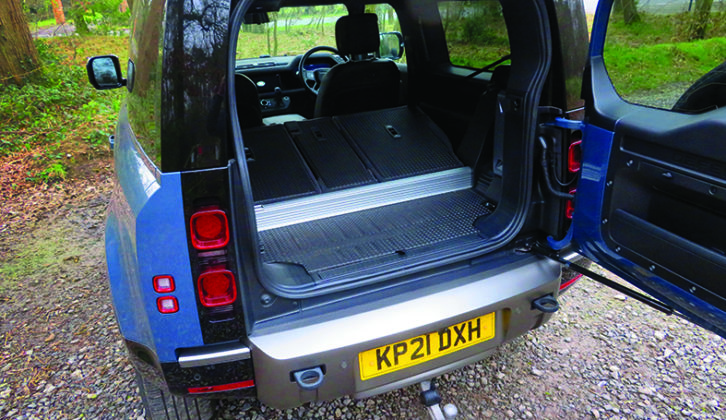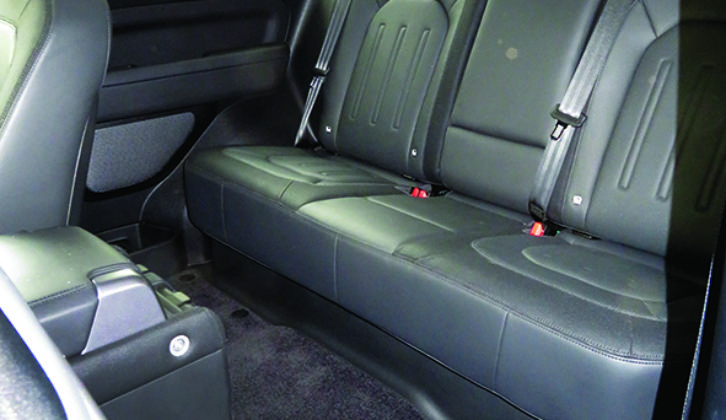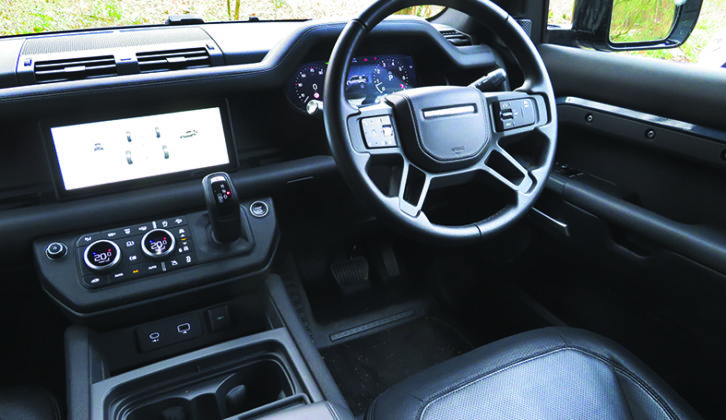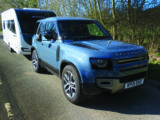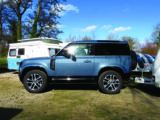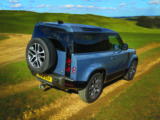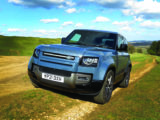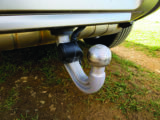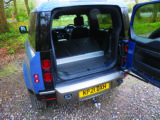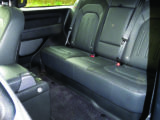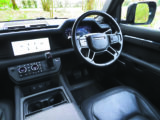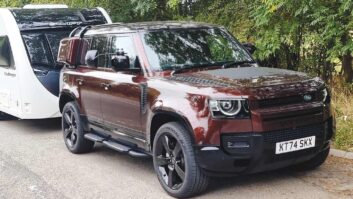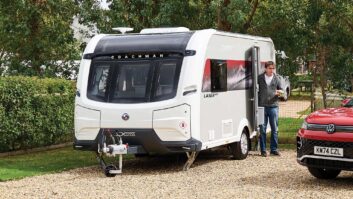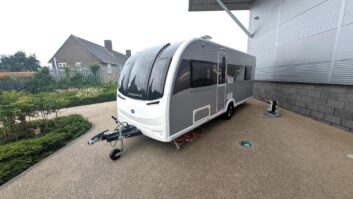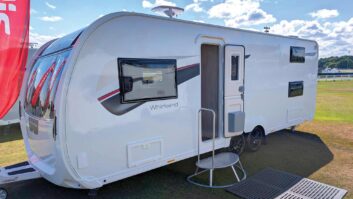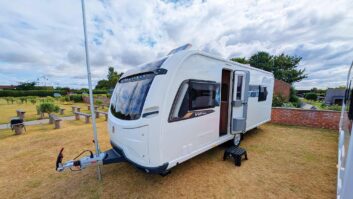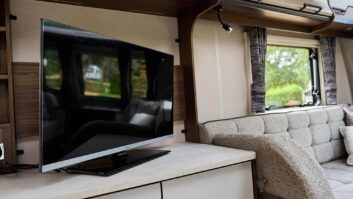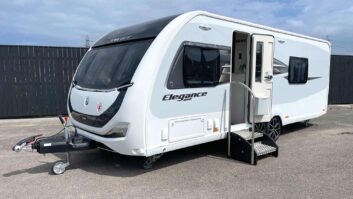We’ve driven the Land Rover Defender 110 before and came away very impressed by its towing ability. This is our first chance to tow with the smaller Defender 90. which has three doors rather than five.
It’s also the first time we’ve been behind the wheel of a petrol, in this case the P300 with its 300hp 2.0-litre engine.
This particular engine is not currently being offered in new Defenders – Land Rover blames the shortage of semiconductors affecting the whole motor industry – but nearly new examples are available.
The X-Dynamic model we have been driving is intended to bridge the gap between the standard Defender and the expensive X versions, with a tougher look than the regular car.
What are we looking for?
Is the petrol Defender’s towing fuel economy acceptable? How practical is the smaller Defender 90 compared with the 110?
Towing ability
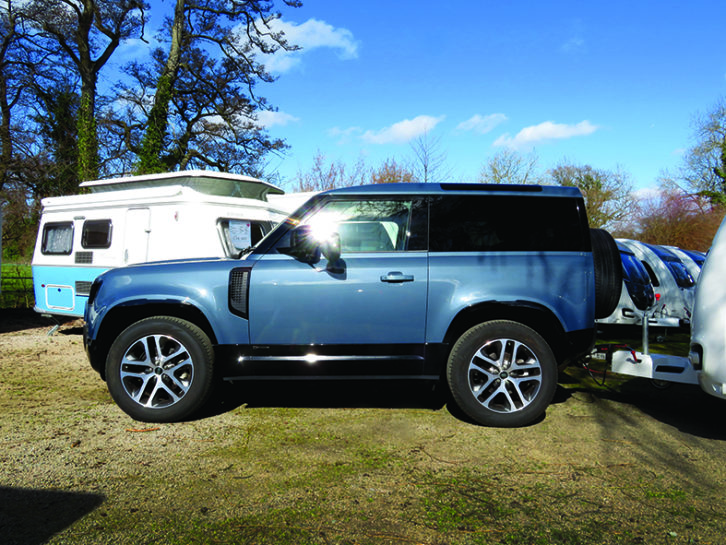
The bigger Defender 110 is one of our favourite heavyweight tow cars, so the smaller 90 has a lot to live up to. Although not as large as the 110, the 90 is still a hefty vehicle, with a kerbweight of 2140kg. That gives an 85% match figure of 1819kg, well within the legal towing limit of 3500kg.
Although the Defender 90 is certainly heavy enough to make a sensible match for a large, luxury caravan, will the engine be up to the job? Well, despite a capacity of just 2.0 litres, the Land Rover’s petrol engine has 300hp and 295lb ft of torque.
The latter figure is more important when towing, and while a diesel Defender D250 has 420lb ft, the P300’s output is healthy by petrol standards.
We matched the Land Rover to a Swift Conqueror 560 with a MiRO of 1558kg. The Defender confidently pulled the Swift up to speed with no sign of strain.
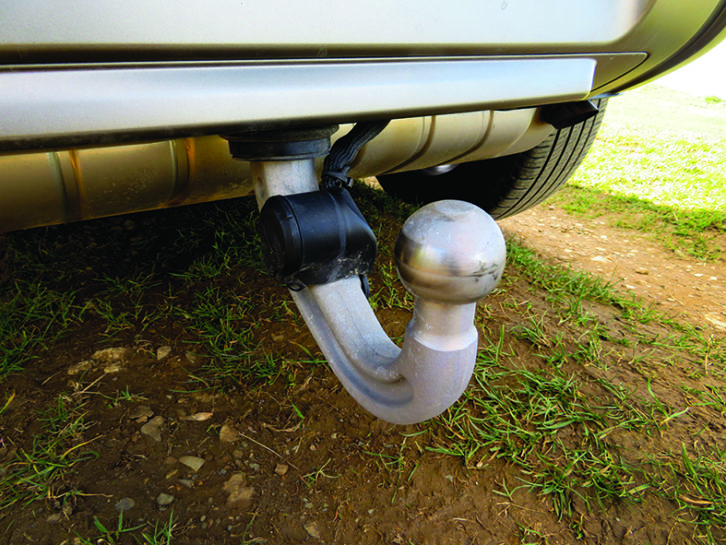
When towing uphill or accelerating past slower traffic, the eight-speed automatic gearbox probably needed an extra downshift to keep the engine on the boil, but we didn’t miss the diesel’s additional torque. It helped that the auto swapped ratios cleanly.
Hill starts were a doddle. The electronic parking brake held the car and caravan still and released smoothly, and the Defender put its power to the road with no wheelspin, even if we were heavy on the throttle. We did wonder if the 90 would be as stable while towing as the bigger 110. We needn’t have worried. Despite having a 43cm shorter wheelbase, the 90 proved extremely secure at speed. We felt hardly a twitch overtaking high-sided vehicles, although calm weather gave the Land Rover a relatively easy time.
It’s the opposite end of the speed range where towing with e Defender is less straightforward. A suite of cameras gives a clear view of the towball when reversing towards a caravan, but when we tried to hitch up, we found the stabiliser lever fouled the spare wheel.
The same problem troubled us when testing the 110, and we worked around it by opening the side-hinged tailgate.
However, in the confines of the caravan dealer’s forecourt, we couldn’t find an angle that allowed us to reverse up to the van without the open tailgate hitting it. We had to remove the stabiliser handle and refit it after hitching up. We’ve heard from owners who have had similar trouble.
You would think that with so many customers towing trailers, horse boxes and caravans, Land Rover would have uncovered this problem and fixed it. But this annoying issue aside, the Defender really does tow beautifully.
Solo driving
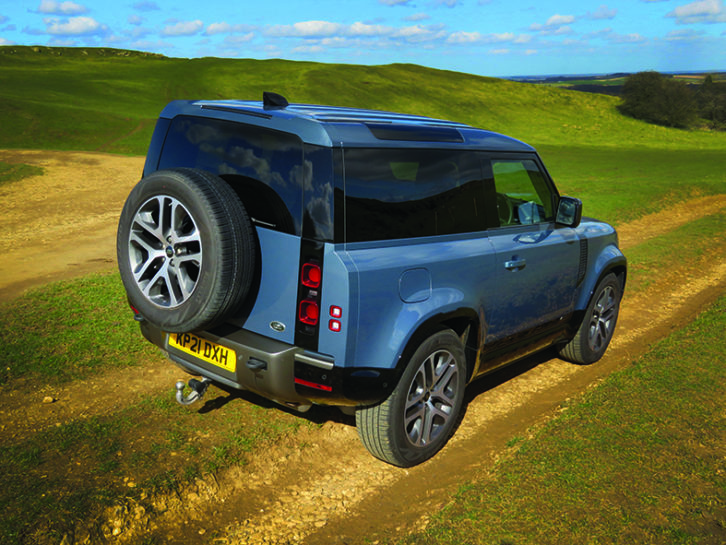
The Land Rover is a relaxing, comfortable way to travel. Being significantly shorter than the 110 makes the 90 less unwieldy than the larger model, although it’s still happiest being driven at a pace between sedate and sensible.
Drive briskly on a twisting B-road and the Defender leans when cornering and feels a tad floaty over dips and crests.
If you want a truly sporty SUV, try the BMW X5. If you’d rather waft around in luxury, the Defender ticks all the boxes.
As standard, the 90 has conventional coil springs, but our test car was fitted with the uprated electronic air suspension. This is a pricey option (£1615), but if you’re going to spend this kind of money on a tow car you might as well get the most from it, and there’s no doubt the air suspension makes for a very smooth ride.
If you’re going to use your Defender off road, it also gives the option of raising the ride height further to cover uneven terrain.
Stick to Tarmac, and the Defender is well suited to all types of journey. Being shorter than most big 4x4s, the Land Rover feels more at home in town than many rivals. On A-roads and motorways, the car is impressively quiet, with little wind noise despite its shape.
The engine performs strongly. It doesn’t rest as easy on the ears as a six-cylinder engine, but doesn’t sound coarse or strained, either. There’s plenty of punch for assured overtaking.
Space and practicality
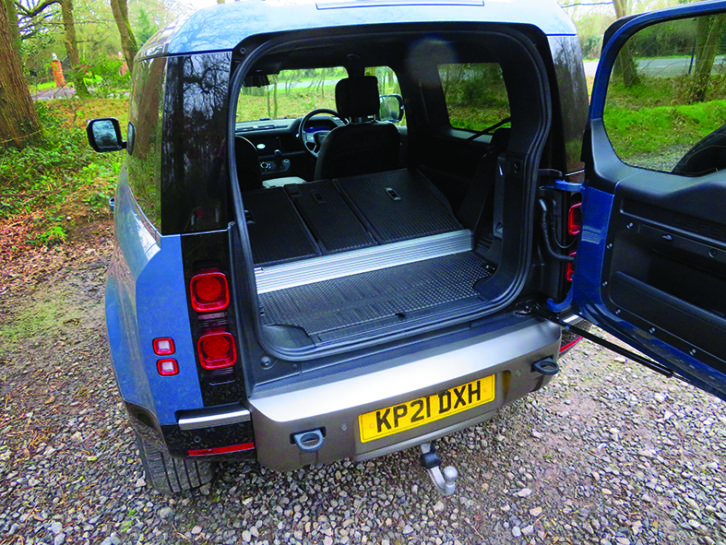
Climb into the cabin and you sit up high, even by 4×4 standards, with a clear view ahead. It’s a shame rear visibility isn’t better, though. The spare wheel and central headrest get in the way.
However, with a wide range of adjustment for the seat and steering wheel, drivers of most shapes and sizes should find a comfortable position.
With its leather upholstery, high-tech infotainment and wipe-clean floor, the Defender’s cabin brilliantly combines both luxury and utility.
The sat-nav screen is large and clear, although it sits in the middle of the centre console rather than on the top, where it would be easier to look at without taking your eyes from the road. We think the iDrive system fitted to BMW’s 4x4s is more intuitive than Land Rover’s Pivi Pro infotainment, but otherwise the Defender’s system is very impressive. It’s compatible with Apple CarPlay and Android Auto.
Climbing into the back of the car takes some effort. Although the driver and front passenger seats tilt then use electric motors to slide forwards, you still need to take a big step into the cabin and the opening is narrow.
Once in the back, there’s plenty of legroom for adults. Air vents between the front seats will keep those in the back comfortable, and there are lots of 12V and USB sockets so you can charge all manner of phones and other devices.

It’s a real shame there’s not more luggage room. The official figures show 397 litres for bags, but this flatters a space that’s wide and tall but not very long.
Loading up with anything heavy will be potentially back-straining work as the boot floor is so high. The air suspension does help a little here, though, because the back of the car can be lowered.
Folding the rear seats leaves a pronounced step in the floor, although it does increase the luggage space to 1960 litres.
Buying and owning
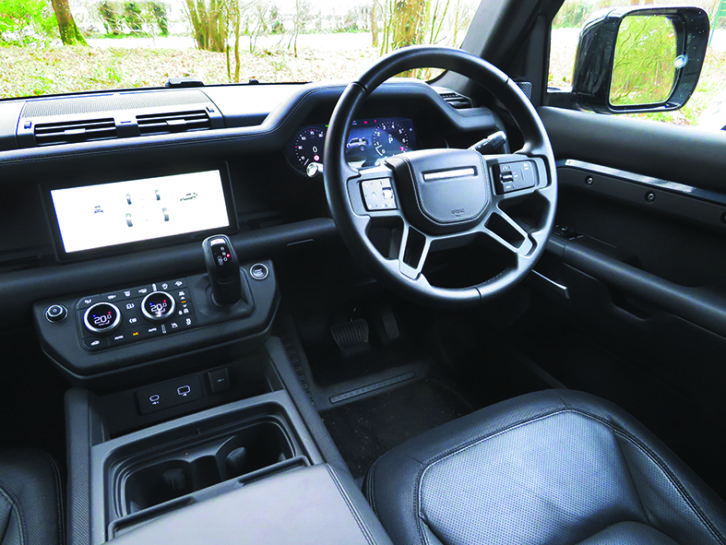
As a new vehicle, the P300 X-Dynamic SE was priced at £53,930. At the time of writing, a shortage of semiconductors means it is not possible to buy this model brand new.
Online, we found nearly new cars in this spec, with lots of extras, priced from £72,000, so buying used is not yet the route to a cut-price Defender.
It’s expensive to buy and to run. We saw mid-20s mpg in solo driving on the motorway. That dropped to 17.6mpg when towing the Swift. This makes the Defender petrol one of the thirstiest cars we’ve towed with. No wonder Land Rover has prioritised producing diesel and plug-in hybrids.
VED is also expensive. The surcharge for cars priced at over £40,000 applies, so the annual bill is £490 for the first five years after the first year.
Insurance shouldn’t be too painful, as the car sits in group 37. Strong resale values mean you can expect to get back a healthy percentage of whatever you pay for your Defender after a few years, but otherwise, this is an expensive car to own.
How much will it cost on finance?
We couldn’t find a deal for the Defender 90 P300, but the D250 diesel in the same spec could be yours for £788.28 per month. That’s the monthly price for leasing the car over three years from Nationwide Vehicle Contracts, with annual mileage capped at 10,000 and an initial payment equivalent to nine months’ rental. Maintenance is not included.
Verdict
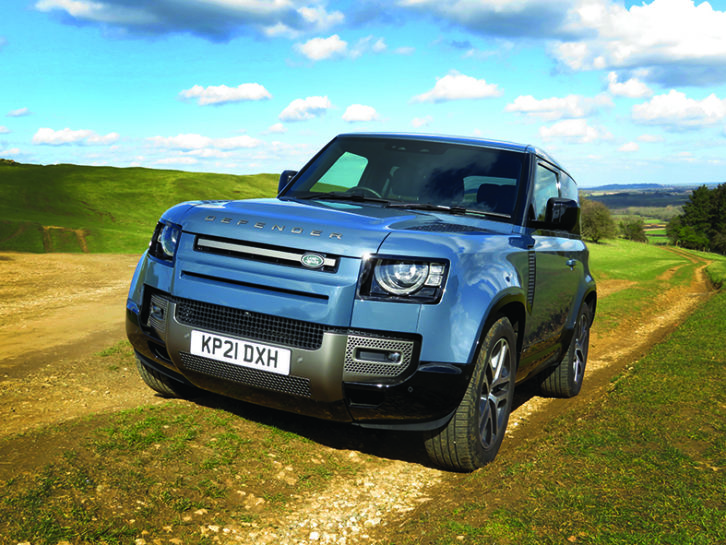
The Defender is one of our favourite tow cars, but the 90 P300 is a long way from being the strongest model. For starters, the 110 is almost as good-looking as the 90, but a while lot more practical. Unless you rarely need the rear seats, the 110 is the model we’d recommend.
We’d also avoid the P300. It drives well, both in solo driving and while towing, but the fuel economy is not impressive; We can just about see why a very low-mileage driver would choose it, but for most uses, a diesel or plug-in hybrid would be more appealing.
Otherwise, the P300 shares the many strengths and few weaknesses of the rest of the Defender range.
The spare wheel getting in the way when hitching up is probably the biggest weakness as a tow car.
Once you’ve finished cursing, and car and caravan are securely connected, you’ll enjoy excellent stability. Relaxed road manners make long journey pass with ease, and the Defender will happily hold 60mph towing a heavy tourer without breaking a sweat.
Getting into the back of the Defender 90 takes a bit of effort, but once everyone has found their seat, the cabin is comfortable and quiet. We really like the design, with its clever combination of utility and luxury.
In solo driving, the Defender isn’t the sharpest of SUVs, but it is comfortable on Tarmac and superbly capable off road. We’d be happy to live with a Land Rover Defender, but choosing the short-wheelbase petrol over the rest of the range is hard to justify.
You can also take a look at our used Land Rover Discovery 4 guide if you’re looking to find out about other models from the brand.
If you liked this… READ THESE:
Review: Land Rover Defender 110 D240 SE
Review: Volvo XC90 B5 AWD R-Design
Review: Mercedes-Benz G-Class 350d
If you’ve enjoyed reading this article, why not get the latest news, reviews and features delivered direct to your door or inbox every month. Take advantage of our brilliant Practical Caravan magazine SUBSCRIBERS’ OFFER and SIGN UP TO OUR NEWSLETTER for regular weekly updates on all things caravan related.
Despite having a 43cm shorter wheelbase, the 90 proved extremely secure at speed. We felt hardly a twitch overtaking high-sided vehicles
Technical Specifications
| Engine Size | 1997 cc |
| Kerbweight | 2140 kg |
| 85% KW | 1819 kg |
| Towball Limit | 150 kg |
| Maximum Towing Limit | 3500 kg |
| Power | 300 bhp |
| Torque | 295 lb ft |
| Offical MPG | 22.7 mpg |
| Towing MPG | 17.6 mpg |
| CO₂ | 259 g/km |
